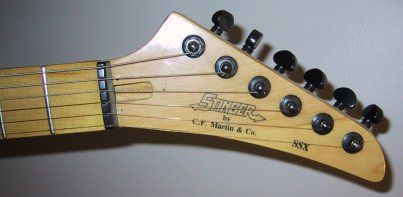Long Last | home
C.F. Martin Stinger
The Martin Company imported electric solidbody guitars from Asia from about 1985 to 1995. Most of
these guitars came from a Korean company called Samick. Samick is the major supplier of Epiphone guitars for
the Gibson Company. Although the Martin company did not build this instrument the guitar was built to
Martin's specifications. This model is called the SSX. The SSX came in a variety of colors including white (pictured) red,
black and tourqoise. The SSX is basically a Fender strat 5 position 3 pickup electronic configuration on a modified Charvel
Jackson styled body.

This instrument has the longer scale neck with a maple fingerboard. The maple fingerboard gives a brighter tone
as compared to rosewood or ebony. I used this instrument for Country style music because it gave me a nice
combination of Stratocaster/Telecaster sounds. It has medium jumbo frets (very good condition) and has had the
bridge intonation set to pitch. The orignal jack plate broke (extremely common) and was replaced with a homemade
solid brass jack plate (it won't brake). The little black knob that goes on the 5 position selector switch is missing, they can be replaced
for a buck or two.

The over all condition of this instrument is very good. It does have a couple of minor dings in the body (paint). It has been a work horse
guitar for me for a decade. I have bought a G&L "tele" ASAT and I can't put it down! So... I don't play the SSX anymore

The truss rod cover plate is missing (see photo), I think it is in my junk drawer somewhere.
I think it looks cool with out the truss plate cover.
A brief history of Asian electric copies such as this SSX Stinger. The Japanese originally were the first Asian country
to start copying American made electric guitars. In the 1970's many Japanese music companies bought up a load of vintage American electrics such as Gibson Les Paul's, Fender Strats and Tele's and old Gretsch guitars. They disassembled many of these same instruments and spec'd out everything from the fingerboard material and thickness to the gauge and number of wire wraps on the pick ups. They measured the magnetic strength of pick up magnets, the thickness of finishes and every other part of these instruments imaginable. Some of these companies then set out to duplicate these instruments to a nearly identical manufacturers specification. The end result was pretty amazing… They do excellent work! In turn, Korean piano companies such as Samick and Young Chang began competing with the Japanese companies in the late 70's and early 80's. Their labor costs were lower and their ability to produce high quality music instruments eventually (in some people's opinions) rivaled the Japanese companies.
What does all of this mean now? It means that Korean guitars from quality companies are incredible values. These guitars are close copies to vintage era American guitars such as Gibson and Fender. Some of these instruments can come pretty close to sounding like extremely valuable 1970's vintage electrics. Some people may argue that it is not possible for Korean or Japanese electrics to sound like a 1967 Stratocaster.. the proof is in the pudding! Electric guitar construction is not that complicated. If a certain type magnet is wrapped with a certain type and gauge of wire it will identically pick up the same electromagnetic signals as any other identical pickup; this is pure physics, it is not a mystical art involving solar eclipses and secret ceremonies. When a piece of swamp ash is cured, milled, and machined it is essentially the same material whether that work is done in Southern California or Seoul Korea. Stradivarius took instrument building secrets to his grave, a computer controlled router has no secrets.
The Martin company primarily used the Samick Piano company as its supplier for the Stinger series guitars. Samick is a world renown music company that has built more guitars than any other company in the world. They have built guitars for Fender, Gibson, Jackson, Washburn and a host of other small American guitar companies. Currently Gibson is rumored to be in preliminary negotiations to buy the Samick company. This marriage would serve Gibson due to the fact that the vast majority of the Epiphone guitar line is built by Samick in Korea.